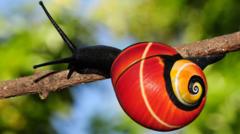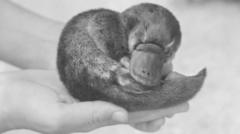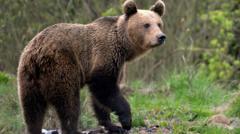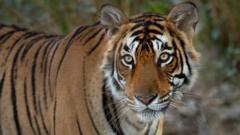Recent research indicates that the world's tallest mammals are more genetically diverse than previously understood, leading to a new classification system that aims to enhance conservation efforts.
New Discoveries Redefine Giraffe Species Count: Four Recognized Instead of One

New Discoveries Redefine Giraffe Species Count: Four Recognized Instead of One
Scientists have announced the recognition of four distinct giraffe species, a significant revision from prior beliefs that there was only one.
The International Union for Conservation of Nature has confirmed the existence of the Southern, Reticulated, Northern, and Masai giraffes, which face varying levels of vulnerability and require tailored conservation strategies.
Giraffes, often viewed as a singular species, have recently been identified as four distinct species based on new scientific assessments. The International Union for Conservation of Nature (IUCN) has confirmed that these majestic animals are more genetically diverse than previously thought, leading to their classification into four groups.
The Southern giraffe, native to regions like Angola, Botswana, and Namibia, was found to be separated from other giraffes by rivers and rainforests. The Reticulated giraffe inhabits areas of Kenya, Somalia, and Ethiopia, with natural features such as the Tana River contributing to its distinct evolution. The Northern giraffe's habitat includes western Ethiopia and areas of central Kenya, separated by the Nile River and patterns of migration. Lastly, the iconic Masai giraffe, known for its unique spotting, resides in Kenya, Tanzania, and Uganda, and is similarly separated from the Northern giraffe.
Michael Brown of IUCN commented on the importance of understanding these genetic differences for effective conservation. Giraffes have been classified under a single "vulnerable" status, but the newly recognized species will now be evaluated separately, enabling more tailored protection strategies.
This groundbreaking classification reflects a deeper understanding of giraffe evolution and underlines the urgency of conservation efforts as these species navigate threats of extinction in their habitats.
Giraffes, often viewed as a singular species, have recently been identified as four distinct species based on new scientific assessments. The International Union for Conservation of Nature (IUCN) has confirmed that these majestic animals are more genetically diverse than previously thought, leading to their classification into four groups.
The Southern giraffe, native to regions like Angola, Botswana, and Namibia, was found to be separated from other giraffes by rivers and rainforests. The Reticulated giraffe inhabits areas of Kenya, Somalia, and Ethiopia, with natural features such as the Tana River contributing to its distinct evolution. The Northern giraffe's habitat includes western Ethiopia and areas of central Kenya, separated by the Nile River and patterns of migration. Lastly, the iconic Masai giraffe, known for its unique spotting, resides in Kenya, Tanzania, and Uganda, and is similarly separated from the Northern giraffe.
Michael Brown of IUCN commented on the importance of understanding these genetic differences for effective conservation. Giraffes have been classified under a single "vulnerable" status, but the newly recognized species will now be evaluated separately, enabling more tailored protection strategies.
This groundbreaking classification reflects a deeper understanding of giraffe evolution and underlines the urgency of conservation efforts as these species navigate threats of extinction in their habitats.






















